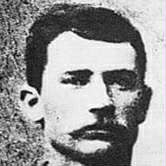
d: 1884
Henry Newton Brown
Summary
Name:
Years Active:
1878 - 1884Status:
DeceasedClass:
MurdererVictims:
6Method:
ShootingDeath:
April 30, 1884Nationality:
USA
d: 1884
Henry Newton Brown
Summary: Murderer
Name:
Henry Newton BrownStatus:
DeceasedVictims:
6Method:
ShootingNationality:
USADeath:
April 30, 1884Years Active:
1878 - 1884bio
Henry Newton Brown was born in 1857 in Cold Springs Township, Phelps County, Missouri. Orphaned at a young age, he was raised by his aunt and uncle, Jasper and Aldamira Richardson, until the age of 17. At that point, Brown left home and headed west, embarking on a transient life working as a cowboy in Colorado and Texas. During this time, he reportedly killed a man in a gunfight in the Texas Panhandle, though documentation is lacking.
In 1877, Brown settled in New Mexico and became involved in the infamous Lincoln County War. He joined Billy the Kid as part of the "Lincoln County Regulators," a group formed to avenge the murder of English rancher John Tunstall. Brown quickly became known for his deadly efficiency with firearms, earning a reputation as a "two-gun man." Although he was implicated in several killings during the conflict, including the assassination of Sheriff William Brady and participation in the Gunfight at Blazer’s Mill, Brown evaded formal prosecution at the time.
After the war's collapse in mid-1878, Brown fled New Mexico, wisely avoiding arrest warrants. He wandered through Texas and later the Oklahoma Indian Territory, ultimately settling in Kansas. There, he reinvented himself as a lawman. By July 1882, Brown had settled in the rowdy cattle town of Caldwell, Kansas, first as Assistant Marshal and soon promoted to City Marshal. His tenure marked a dramatic reduction in violent crime.
Ironically, Brown's mild personal habits—he didn’t drink, smoke, or gamble—and his devout Methodist faith made him a respected figure in Caldwell society. In 1883, he married Alice Maude Levagood, the daughter of a prominent brick maker, elevating his social standing even further. Brown was known to be introverted and modest but transformed into a commanding and fearless figure when on duty. He became something of a local legend, praised for cleaning up Caldwell and awarded a silver-engraved Winchester rifle by grateful citizens in December 1882.
murder story
Despite his respected role as a lawman, Henry Newton Brown's final chapter was steeped in betrayal and irony. On April 30, 1884, he and his deputy, Ben Wheeler—also a former outlaw—attempted to rob the Medicine Lodge Bank in Kansas. Brown, who had once vowed to uphold the law, turned to crime once again, likely motivated by financial desperation or the allure of quick wealth.
The attempted robbery failed. A gun battle broke out during the heist, leading to the death of bank president Wylie Payne and the serious injury of another employee. Brown and Wheeler were captured by townspeople shortly after the shootout. News spread quickly, and public outrage boiled over.
Before law enforcement could transfer them to a secure facility or initiate formal charges, an enraged mob of local citizens took matters into their own hands. That very night—April 30, 1884—Henry Newton Brown was dragged from his jail cell and lynched in the street alongside Wheeler. No trial was ever conducted, and no formal conviction was issued. His death marked the tragic end of a man who had, at various times, fought both for and against law and order in the American West.
Brown’s story remains a classic case of the dual identities that characterized many figures of the Old West: both hero and outlaw, protector and killer.